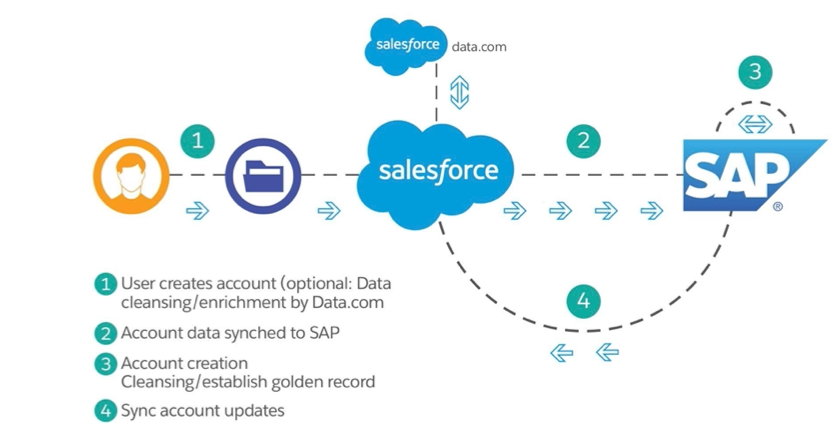Salesforce and SAP for bidirectional account creation and maintenance are crucial for successful Salesforce and SAP integration. By seamlessly synchronizing data between Salesforce’s CRM and SAP’s ERP, organizations can maintain consistent account information, streamline operations, and boost overall efficiency.
This tutorial will guide you through the benefits, provide real-world examples, and offer a step-by-step implementation guide for integrating Salesforce and SAP for bidirectional account maintenance.”.
What is Bidirectional Integration?
Bidirectional integration means establishing a two-way flow of data between two systems, in this case, Salesforce and SAP. When changes are made in Salesforce, they are reflected in SAP, and vice versa. This approach ensures that both systems have consistent, up-to-date information, which minimizes errors and streamlines processes.
- Manual corrections by data stewards help maintain the quality of data before it is committed to the system of record.
- Users need the ability to create and maintain accounts using the Salesforce platform.
- Integration between Salesforce and SAP or an MDM platform ensures seamless synchronization of account data.
- Synchronization maintains consistency of customer information across all systems.
- Integration helps multiple teams access up-to-date and consistent customer data.
- Data governance standards must be followed to ensure data accuracy and reliability.
- Data stewards are responsible for validating or authorizing account data changes.
Benefits of Bidirectional Account Integration
- Data Consistency: Keeps account data synchronized across both Salesforce and SAP, reducing discrepancies and minimizing errors.
- Operational Efficiency: Eliminates manual data entry, freeing up valuable time and resources for more strategic tasks.
- Enhanced Customer Experience: Provides sales, service, and finance teams with real-time, accurate information, improving customer interactions and decision-making.

Key Considerations for Successful Integration
To achieve seamless Salesforce and SAP integration, it’s crucial to plan and strategize effectively. Here are some important factors to consider:
1. Define Integration Requirements
Identify the data entities that require synchronization, such as accounts, contacts, and related records. Define specific triggers for synchronization, such as creating, updating, or deleting records.
2. Evaluate Integration Tools
Choose the best integration tool for your use case. Options include:
- APIs: REST and SOAP APIs offered by Salesforce and SAP.
- Middleware Solutions: Platforms like MuleSoft or SAP CPI help establish communication and simplify integration processes.
3. Data Mapping and Transformation
Ensure that fields from Salesforce are accurately mapped to corresponding fields in SAP. Sometimes, data formats may need transformation to align data structures between the two systems.
4. Error Handling and Monitoring
Incorporate error handling and logging mechanisms to ensure issues during synchronization are tracked and resolved effectively.
5. Security and Compliance
Ensure that data being exchanged complies with industry security standards and legal requirements. Implement proper authentication protocols to protect sensitive information.
Step-by-Step Salesforce and SAP for bidirectional account creation
Step 1: Assess Existing Systems
Evaluate your Salesforce and SAP configurations to understand existing data structures and the integration requirements.
Step 2: Choose Integration Approach
Decide whether real-time integration (instant synchronization) or batch processing (scheduled updates) is the best fit for your needs. Real-time integration works well for rapidly changing data, whereas batch processing is cost-effective for non-critical data.
Step 3: Develop Integration Logic
Develop integration logic using APIs or middleware that handles bidirectional data flow between Salesforce and SAP. Set up triggers for creating, updating, and deleting records in both systems.
Step 4: Test the Integration
Perform thorough testing to ensure data integrity and synchronization work as expected. This includes testing with different scenarios, such as data conflicts or failed transfers.
Step 5: Deploy and Monitor
Deploy the integration in your production environment. Continuously monitor the system to ensure smooth operations, track errors, and improve performance.
Real-World Scenario
Consider a manufacturing company that uses Salesforce to handle sales operations and SAP for inventory and order fulfillment. When a sales rep creates a new customer account in Salesforce, this information needs to be immediately available in SAP for inventory and billing purposes. Similarly, if the finance team updates billing addresses in SAP, those changes must reflect in Salesforce to keep sales teams informed.
Example Workflow:
- User Account Creation: A new customer account is created in Salesforce by a sales rep.
- Data Synchronization: Integration triggers synchronization to SAP, where the new account is recorded for further use by operational and finance teams.
- Account Update: Any updates (e.g., change in billing address) made in SAP automatically synchronize back to Salesforce, keeping data consistent across both systems.
Outcome:
This bidirectional synchronization allows every department—from sales to finance—to access the most current and accurate data. It ensures smoother processes and allows teams to work in harmony, ultimately improving customer satisfaction and business efficiency.
Best Practices for Salesforce and SAP Integration
- Start with a Pilot Program: Begin by integrating a small set of data to identify potential issues before full-scale deployment.
- Document Integration Details: Keep detailed records of integration steps, data mappings, and settings for future reference.
- User Training: Train users on the new system so they can effectively utilize the integration and maximize its benefits.
- Monitor Regularly: Continuously monitor the integration process for discrepancies and errors, and adjust the logic as required.
Conclusion
Integrating Salesforce and SAP for bidirectional account creation and maintenance transforms your business operations by ensuring all systems are in sync, reducing manual workloads, and enhancing efficiency. With real-time data availability across Salesforce and SAP, teams can make informed decisions, provide a superior customer experience, and align their workflows with minimal friction. Follow these steps, consider the key factors, and utilize best practices to achieve a seamless and effective Salesforce and SAP integration for your business.
For more detailed tutorials, insights, and step-by-step guides, visit SalesforceTutorial.com and explore our comprehensive resources on Salesforce and SAP integrations.